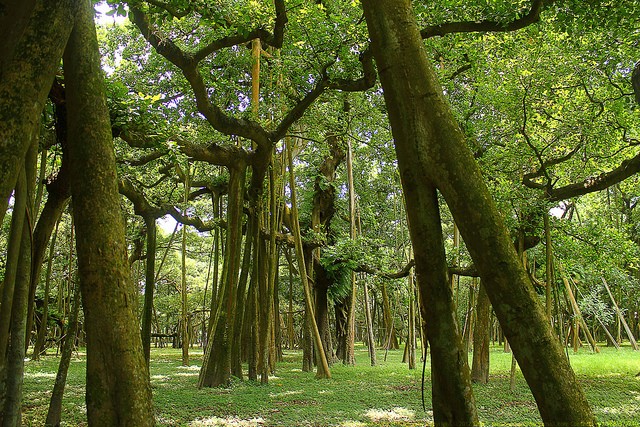
The Great Banyan Tree
This tree is the chief attraction and also the pride and glory of the Garden. It resembles more like a forest than a single tree and evokes awe and wonder in the mind of the vast multitude of daily visitors. The tree has sent down innumerable roots from its branches vertically to the ground and the roots have grown thick and stout to bear all the appearance of so many trunks. The striking development of the aerial roots from branches is peculiarity of the banyan tree. The main trunk of the Banyan tree was about 51 feet in girth in December 1984 and the aerial roots which actually reached the ground at that date numbered 378 and the roots newly formed which did not reach the ground numbered 100.
It may be observed that aerial roots are thrown out from such places where support for the horizontally spreading branches is mostly required. The circumference of the leafy dead of the tree, if its sinnosities be followed, is 976 ft. otherwise it is 858 feet. The tree is not symmetrical and the main steam does not stand on the centre of the space covered by it. The long diameter of the space is 287 ft. and the short diameter is 264 feet. During the great Cyclones of 1864 and 1867 several of the largest limbs on the northern and western sides were removed. Breaking of branches by frequent severe storm of wind during the hot season is a regular feature. The southern side has however hitherto entirely escaped damage by storms. The age of the tree is not actually known but according to current tradition prevailing in the neighbourhood, in 1786 when garden was established, the tree was quite a small tree growing on the top of a wild date-tree. According to this tradition the age of the tree would be 238 years now in 2007.
It may be observed that aerial roots are thrown out from such places where support for the horizontally spreading branches is mostly required. The circumference of the leafy dead of the tree, if its sinnosities be followed, is 976 ft. otherwise it is 858 feet. The tree is not symmetrical and the main steam does not stand on the centre of the space covered by it. The long diameter of the space is 287 ft. and the short diameter is 264 feet. During the great Cyclones of 1864 and 1867 several of the largest limbs on the northern and western sides were removed. Breaking of branches by frequent severe storm of wind during the hot season is a regular feature. The southern side has however hitherto entirely escaped damage by storms. The age of the tree is not actually known but according to current tradition prevailing in the neighbourhood, in 1786 when garden was established, the tree was quite a small tree growing on the top of a wild date-tree. According to this tradition the age of the tree would be 238 years now in 2007.
